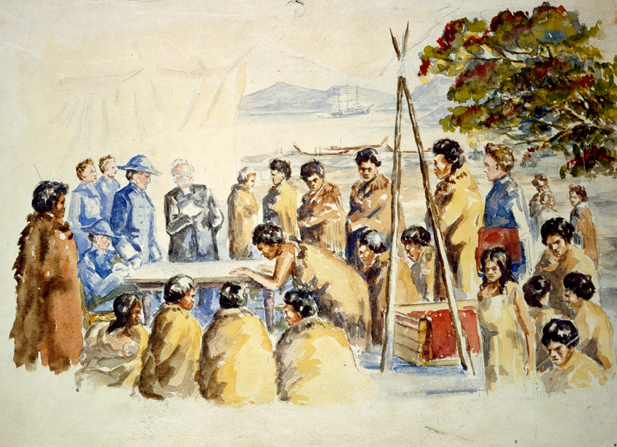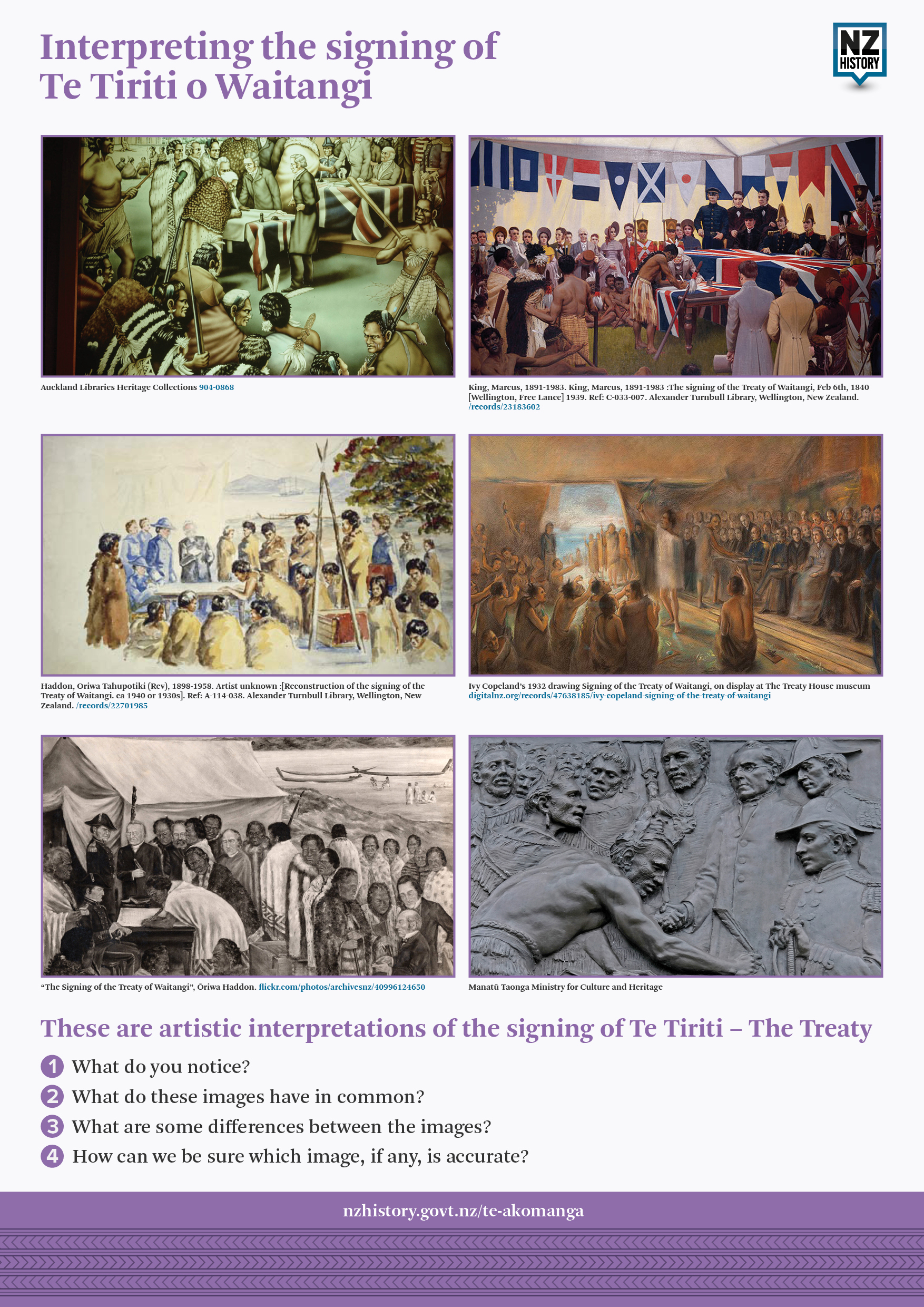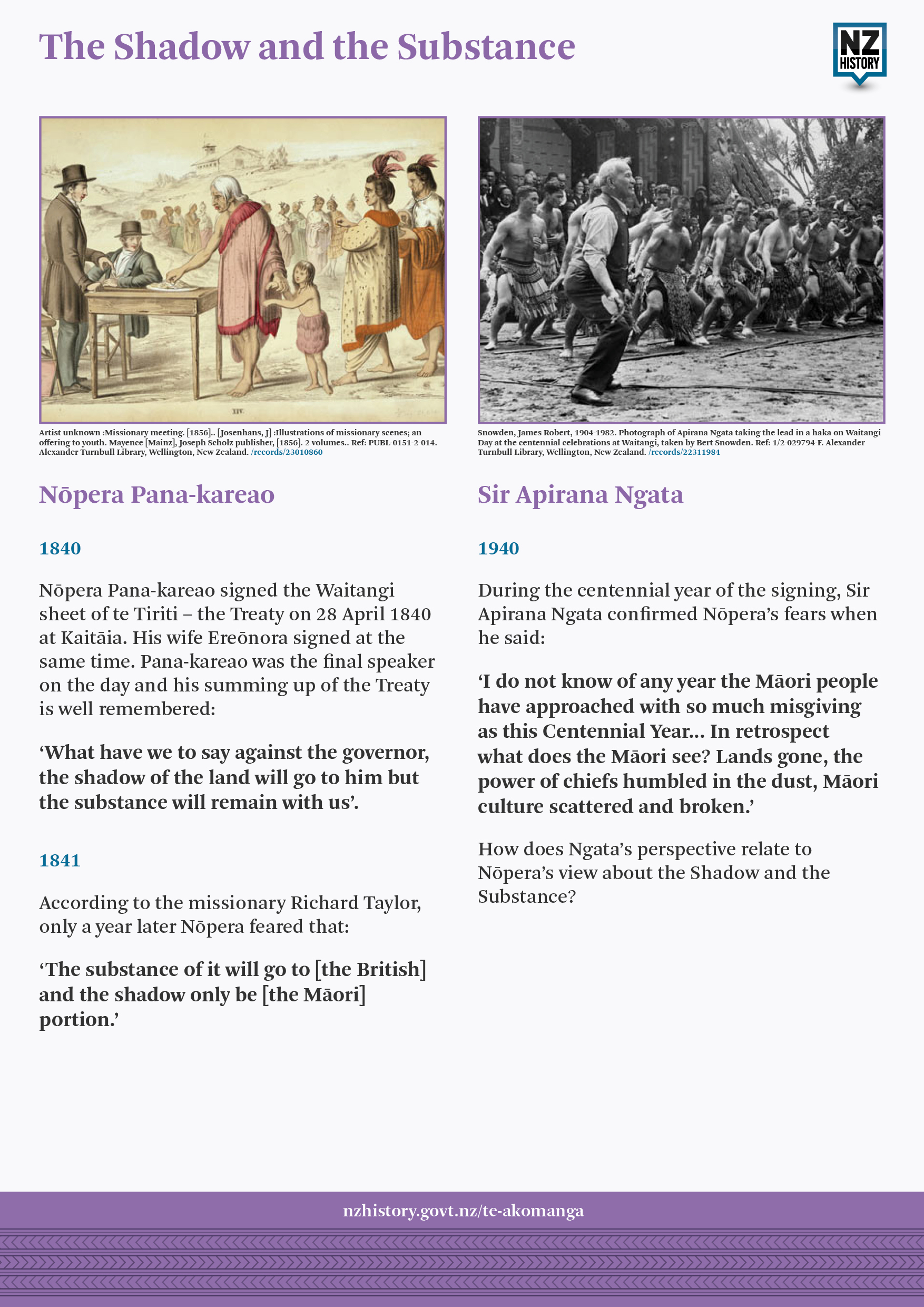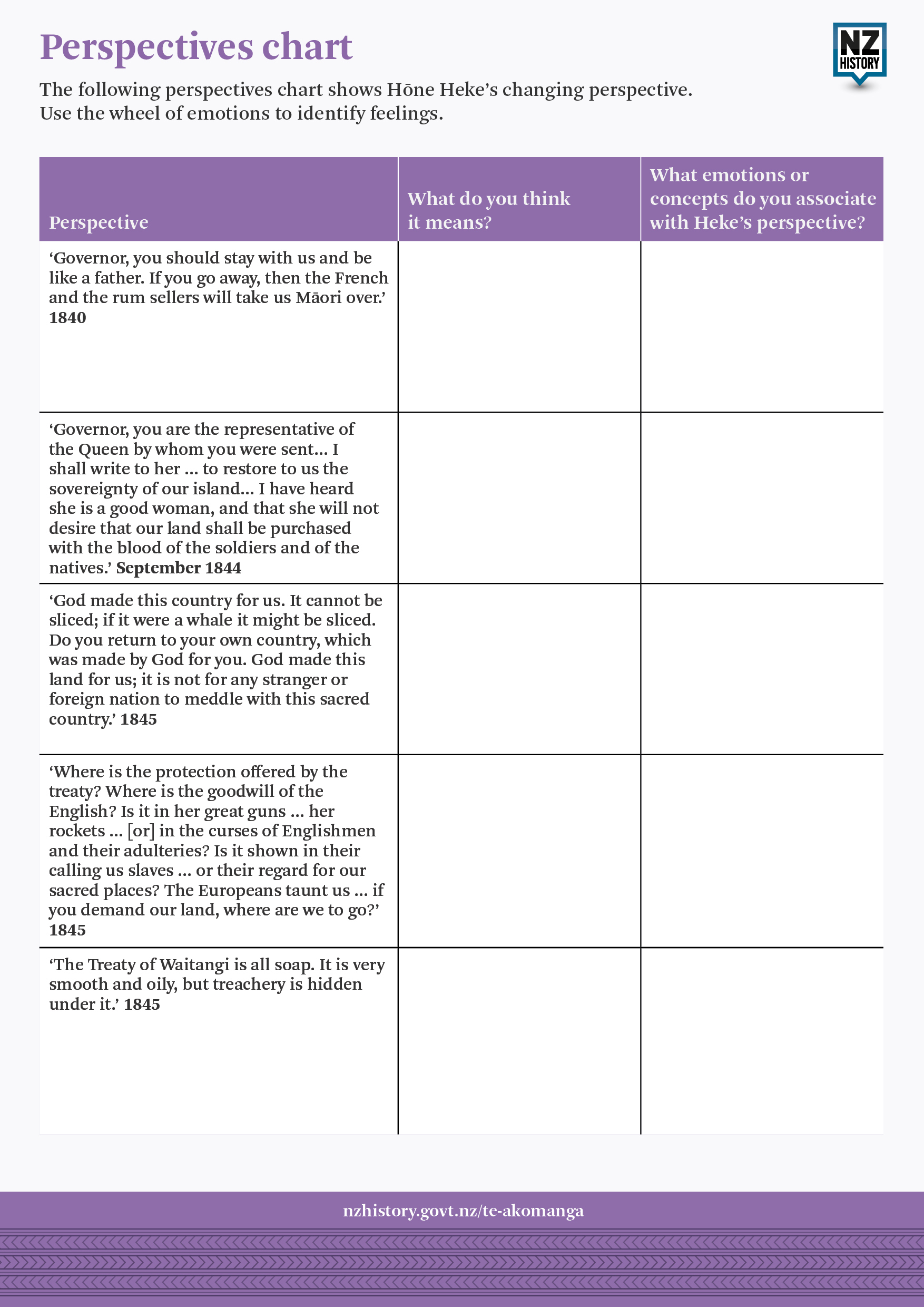
Te Tiriti/the Treaty has been variously described as a founding document, a sacred covenant and a fraud. It speaks through many voices, past and present. So, what are some ways to teach the history of this document and analyse its ongoing impacts? And how do we ensure students don’t feel fatigued and cry out in exasperation, ‘We’ve done the Treaty!’
Using this page
This page begins with a personal recollection about teaching te Tiriti, followed by suggested teaching approaches and activities aimed at Years 7–10. Teachers should feel free to adapt the activities for their specific class.
Key concepts
- mana (power, authority) and whenua (land)
- perspectives/points of view.
Tiriti vs Treaty, and challenging 'Treaty principles'
I once invited the then MP Hone Harawira (Ngāti Hau, Ngāti Wai, Ngāti Hine, Te Aupōuri, Ngāpuhi, Ngāti Whātua) to come and speak to my Year 10 Social Studies class. ‘We’ve been learning about the Treaty principles’, I explained as we walked to the classroom. ‘Why do that?’, he asked, ‘It’s clear what te Tiriti says.’
Legal authority
It is worth noting that te Tiriti is now seen as the authoritative document in a legal context.
Hone’s short reply made me reflect that while I had been teaching perspectives that viewed Treaty principles as an attempt to reconcile the differences between the Treaty and te Tiriti (a quest for the so-called spirit of the thing), I hadn’t been teaching perspectives that saw the principles as a tool used to neutralise te Tiriti.
Hone’s words echoed in my head when I read Ani Mikaere’s book, Colonising myths – Māori realities: he rukuruku whakaaro (2011). Mikaere argues that the development of Treaty principles to resolve tensions between the two texts is misguided and has resulted in te Tiriti being subordinated to the Treaty. She also believes it marginalises He Whakaputanga o te Rangatiratanga o Nu Tireni (the Declaration of Independence).
He Whakaputanga o te Rangatiratanga o Nu Tireni
Signed on 28 October 1835 by 34 rangatira and by a further 18 over the following four years, this document led to the creation of Te Whakaminenga (the ‘United Tribes’), who declared their rangatiratanga (independence) and stated that kīngitanga and mana (‘all sovereign power and authority’) resided in them collectively. Te Whakaminenga declared that they would not permit whakarite ture (‘legislative authority’) to exist apart from themselves, nor would they permit any kāwanatanga (‘function of government’) to be exercised by anyone other than persons who they said could do so.
Mikaere speaks of the essential whakapapa between He Whakaputanga and te Tiriti. Once this connection is understood, the disconnect between te Tiriti and the Treaty needs to be declared. Mikaere says: 'they have absolutely nothing in common with each other… The inextricable connection between He Whakaputanga and te Tiriti should be acknowledged, and the Treaty seen for the historical irrelevance that it truly is.'
Ani Mikaere – Colonising myths – Māori realities: he rukuruku whakaaro (2011)
A call for centring te Tiriti – the Māori text – was heard in 1991 when the historian M.P.K Sorrenson wrote: 'It is the Māori text that gives Waitangi its most distinctive quality. We in New Zealand have not yet come to terms with that.'
A year earlier, during the commemoration of the 150th anniversary of the signing of te Tiriti, Anglican Bishop Whakahuihui Vercoe stressed the need for Māori to speak and warned the government not to produce principles of the Treaty, saying: '...the Treaty is already there.'
Bishop Vercoe's speech at Waitangi, 1990 – Te Ara The Encyclopedia of New Zealand
Yet there are many perspectives and narratives about te Tiriti and what it means for the future. Academic Morgan Godfery, for instance, points to the power of the principles, when he says: 'Today the principles – known colloquially as partnership, participation, and protection – bind the Crown. In the 90s and 2000s the principles were responsible for helping force the government to negotiate over rights to land, fisheries, broadcasting, and more.'
Suggested teaching approaches
To learn about te Tiriti o Waitangi is to learn about mana and understand the importance of whenua; it is to discover the hononga/connection between people and te taiao/the environment. What follows are some suggested approaches and activities.
Concept maps
Start with the conceptual thinking you want to encourage, such as:
- Tino Rangatiratanga (power and autonomy)
- Kāwanatanga (governorship; governance; decision-making)
- Taonga (possessions – material and non-material; anything important)
- Whenua (land)
- Perspectives.
Use concept maps to help students make sense of these ideas. A concept map asks students to:
- Define the concept
- Think about what it leads to
- Show/illustrate/explain what it looks like
- Think of historical/contemporary/personal examples of the concept.
Encourage students to use these concepts in their discussions and their writing. Pin their concept maps to the wall for ongoing reference.
Helpful tips
Utilise Te Takanga o te Wā – Māori history guidelines for a range of Mātauranga Māori approaches.
Te Takanga o te Wā – Māori History Guidelines Year 1–8 – Te Kete Ipurangi (TKI)
Start with what students already know about te Tiriti/the Treaty. Find out what questions they have. Make a note of these and use them to shape future lessons.
Start in the present. The challenge is to avoid Treaty fatigue, which can result from the repetition of the same information year after year. It’s important to look beyond a very basic narrative of events in February 1840. The historical context is important, but any study of te Tiriti needs to address the present as well as the past. Students need to understand how te Tiriti is important to them and how it continues to influence New Zealand society.
Start outside Aotearoa New Zealand. You could read Shaun Tan’s The rabbits, a picture-book interpretation of the colonisation of Australia. In place of people, Tan substitutes kangaroos and rabbits. Ask questions as you go about who is making decisions and why, whose perspective is being shared, and what the consequences are for both the rabbits and the kangaroos.
For younger students, it could be useful to start with some broad questions:
- What is an agreement?
- Think of a time when you made an agreement with someone. What was it about? How did you reach the agreement?
- Has someone ever broken an agreement that you’ve had with them? How did you feel? What did you do?
Images
Images can ignite conversations. The Ministry of Education has provided an overview of how images can stimulate curiosity.
Using historical images to stimulate curiosity about the past – Ministry of Education
Resource: Interpreting the signing of te Tiriti o Waitangi
These images are artistic interpretations of the signing of te Tiriti. Get students to ask questions about each image. Talk about what they notice, who is in the image, how are the images similar to or different from each other. Who produced the image and when? How can we be sure which image, if any, is accurate?
Artistic interpretations of the signing of te Tiriti o Waitangi (PDF, 426KB)
Watch
The docudrama What really happened – Waitangi is a great way for older students to explore different perspectives. Students can take notes on the views, values and actions of people like Tāmati Wāka Nene, Hōne Heke, Te Ruki Kawiti, Henry Williams, and William Hobson. Preview it to ensure that it’s age-appropriate for your class and/or select parts to play to your class.
What really happened – Waitangi – NZ On Screen
The Aotearoa History Show episode on te Tiriti o Waitangi covers a lot of ground, beginning with the lead-up to the signing of te Tiriti and the perspectives of rangatira who were present at the signing, before touching on the start of Te Pūtake o te Riri/the New Zealand Wars.
The Aotearoa History Show – Episode 4 | te Tiriti o Waitangi – Radio New Zealand
Hahana Kids explanation of the Treaty of Waitangi could be used with younger students as a way to begin discussions.
The BIG problem with the Treaty of Waitangi – Hahana Kids
This short clip about the Treaty of Waitangi breaks down the differences between the Treaty and te Tiriti and introduces the idea of the Treaty principles.
Treaty of Waitangi – The Treaty Texts – SMC History
Read
Ross Calman, Mark Derby and Toby Morris’s graphic novel Te Tiriti o Waitangi (which includes Teacher Support Materials). The centre spread outlining what is in each article of te Tiriti works well printed off in A3 and handed out for students to write on/annotate/question.
Te Tiriti o Waitangi | School Journal Story Library – Te Kete Ipurangi (TKI)
Treaty of Waitangi page on the Archives New Zealand website for extensive background information concerning te Tiriti.
The Treaty of Waitangi – Archives New Zealand
The translation of the te reo Māori version of te Tiriti by Professor Sir Hugh Kawharu.
Perspectives
The Kōrero section of the He Tohu website has a wide range of perspectives on multiple topics, including Tino Rangatiratanga and He Whakaputanga.
Kōrero | He Tohu – Te Puna Mātauranga o Aotearoa National Library of New Zealand
He Tohu is a permanent exhibition where students can see:
- 1835 He Whakaputanga o te Rangatiratanga o Nu Tireni — Declaration of Independence of the United Tribes of New Zealand
- 1840 te Tiriti o Waitangi — Treaty of Waitangi
- 1893 Women’s Suffrage Petition — Te Petihana Whakamana Pōti Wahine
He Tohu – Te Puna Mātauranga o Aotearoa National Library of New Zealand
Resource: how perspectives change across time
Nōpera Pana-kareao (1840): signed the Waitangi sheet of te Tiriti on 28 April 1840 at Kaitāia. His wife Ereōnora signed at the same time. Pana-kareao was the final speaker on the day and his summing up of the Treaty is well remembered: 'What have we to say against the governor, the shadow of the land will go to him but the substance will remain with us’. According to the missionary Richard Taylor, only a year later Nōpera feared that 'the substance of it will go to [the British] and the shadow only be [the Maori] portion.'
Sir Apirana Ngata (1940): In 1940, the centenary of the signing, Sir Apirana Ngata confirmed Nōpera’s fears when he said, 'I do not know of any year the Māori people have approached with so much misgiving as this Centennial Year... In retrospect what does the Māori see? Lands gone, the power of chiefs humbled in the dust, Māori culture scattered and broken.' How were his words received by the Pākehā who considered him a Māori ‘voice of reason’? Pākehā who were living with their own shadow – colonisation and privilege built on stolen land and ideas about racial hierarchies.
Resource: how perspectives change across a lifetime
The following chart shows Hōne Heke’s changing perspective toward te Tiriti over his lifetime. Use the wheel of emotions to identify feelings.
Perspectives chart (PDF, 111KB)
Local-based approaches to teaching te Tiriti
While the first signing of te Tiriti happened on 6 February, this is not the significant date for other rohe/regions. Over seven months, nine copies of te Tiriti (including the Waitangi sheet) were signed at many different locations.
Ngā Wāhi – Treaty Signing Occasions – NZHistory
If you have connections with mana whenua, ask them to share what te Tiriti o Waitangi means to them.
If you’re teaching in Te Wai Pounamu (South Island), check out this interactive history about the signing of te Tiriti by rangatira Iwikau (Ngāti Rangiamoa) and Tikao (Ngāi Te Kahukura).
How te Tiriti o Waitangi was signed in Horomaka – Te Rūnanga o Koukourarata
Further resources
Te Tai Treaty Settlement Stories – Iwi and Manatū Taonga Ministry for Culture and Heritage
Year 9 and 10 students are expected to know about the Waitangi Tribunal and Treaty settlements. Check out Te Tai Treaty Settlement Stories for a range of iwi stories and education resources related to settlements.
This timeline of events related to te Tiriti could help students develop their understanding of key events happening around 1840. You could select some specific events, take away the date, cut them out and see whether students can put them in chronological order. Students could be assigned an event and asked to find out more about it.
Treaty of Waitangi: What was lost – Stuff
This article looks at the scale of losses for Māori as a result of colonisation. It touches on land, economy, population and culture.
Curated teaching and learning resources related to te Tiriti o Waitangi / The Treaty of Waitangi and its history.
Resources – Network Waitangi Ōtautahi
Range of excellent te Tiriti resources, including posters.
Taringa podcast | Ep 225 – Te Waananga o Aotearoa
Dayle Takitimu talks about the importance of recognising oral history evidence and iwi perspectives surrounding te Tiriti. A discussion of Treaty principles begins around 29.00.
Why did Māori leaders sign Te Tiriti? – E-Tangata
Dame Claudia Orange looks at why many rangatira signed te Tiriti.
Ten of the most memorable Waitangi Days – The Spinoff
Jamie Tahana looks back on 10 times Waitangi Day has made a particularly big impact.
Ricky Prebble, Educator–Historian




Community contributions